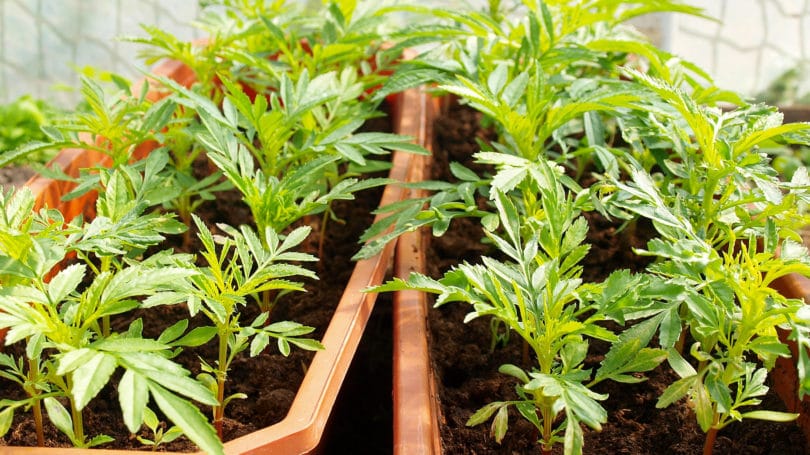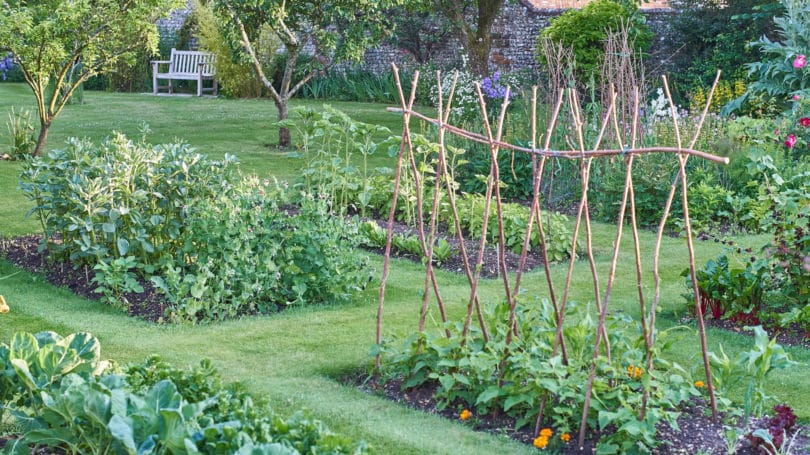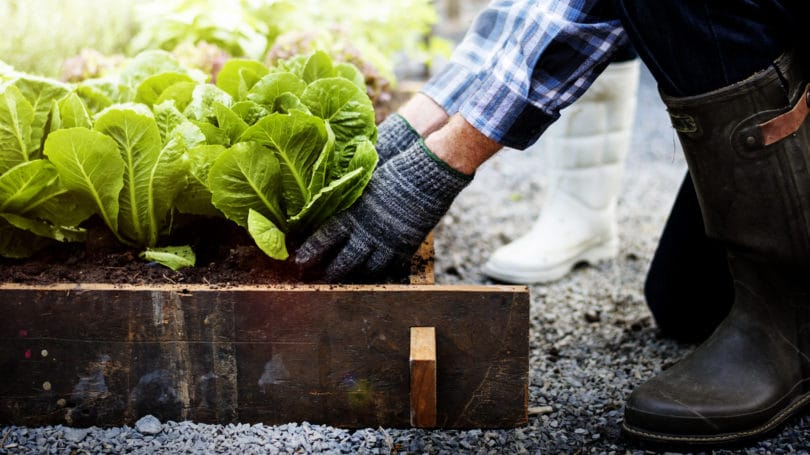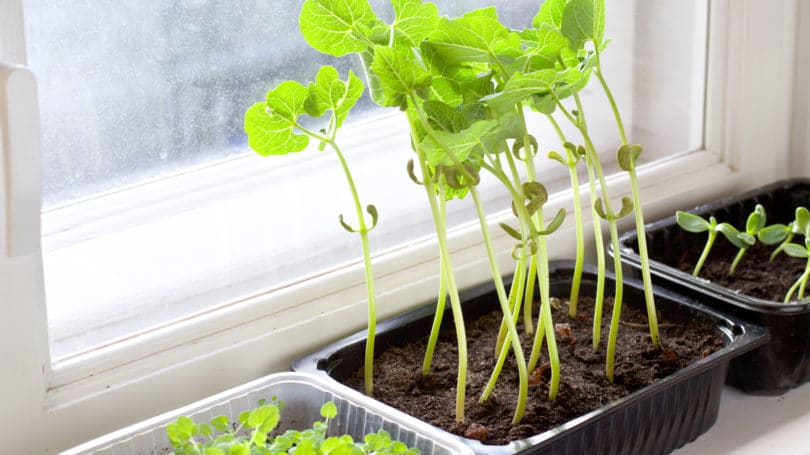4 Home Vegetable Garden Ideas & Types on a Budget
I remember watching my mother working in her garden when I was a teenager, not truly understanding any of the benefits. I remarked that I wouldn't ever have an interest in gardening before the age of 40. Now, though I'm still eight years away from that milestone, I've discovered my green thumb.
With the rising cost of food and gas, I've realized the practicality, as well as the fun, of home gardening. But if you're concerned about the amount of work involved or the cost, don't be. There are plenty of ways to start your own home vegetable garden without spending a fortune.
Types of Home Gardens
1. The Container Garden
This is the kind of garden I'm keeping – it's an easy way to start, and works well if you have limited space. This is just my second year container gardening, and last year I struggled: The lettuce burned up in the sun, the peppers grew into a lovely plant with no actual vegetable, and the squash vines choked out the tomato plants but never actually bore fruit.
Like me, you may have a trial-and-error period, but ultimately, it's worth it. This year, I am successfully growing potatoes, basil, and oregano, and the first few sprouts of greens and spinach are starting, which makes me feel confident that this year will be a success.
Supplies Needed
Container gardens are very easy to set up and get started. The only supplies you need are:
- Containers
- Gardening soil
- Hand rake or tiller
- Seeds
- Water
- Compost (for heavy-feeding plants like squash)
The amount of money you need to spend on your initial setup will depend on where and when you purchase your supplies. During the gardening months of early spring, most feed, grocery, and dollar stores practically give their gardening soil away. Containers will range anywhere from $5 to $10 apiece, while the rest of your items, such as seeds and hand rakes, generally range in price from $2 to $5 per item.
Overall, a small patio container garden should cost you no more than $100 for initial setup – and will probably cost much less if you grab a few containers from friends and neighbors no longer in need of them.
What to Grow
The most important thing to remember when planting in containers is that the roots of the plants can only go down so far. Make sure your containers are deep and wide enough to accommodate your vegetables. For example, most of my vegetable containers are approximately 12 to 14 inches wide and 10 to 12 inches deep. Depth is especially important when growing root vegetables, such as potatoes.
Here is a list of 10 vegetables that grow really well in containers:
- Tomatoes
- Potatoes
- Cucumbers
- Carrots
- Peppers
- Green onions
- Turnips
- Green beans
- Lettuce
- Squash
While carrots and tomatoes grow well together in the same container, squash needs to be grown in its own separate pot – it's a heavy-feeder that needs lots of compost other plants do not. As its vines grow, it can choke out other plants and keep them from moving past the seedling point.
2. The In-Ground Garden Bed
If you have good soil and a little extra room, the in-ground garden bed can be a very economical choice. An in-ground garden of 500 square feet is enough to feed a family of four for eight months out of the year with plenty left over to share with family, friends, and neighbors.
Supplies Needed
For an in-ground garden, you'll at least need a hand tiller, seeds, and compost. You will also need a trellis and stakes to properly grow tomatoes and squash. A small fence of stones, bricks, or wood will help prevent ground runoff after especially heavy rains.
Approximate Cost
If you have good soil and are going to plant directly in the ground, you'll save a lot of money by not buying gardening soil. Bricks and wood can be inexpensively obtained, and seeds and root vegetables can be taken directly from store-bought produce.
Your cost will depend on the size of your garden. Initial setup can run you anywhere from $100 to $200, if you purchase everything outright.
What to Grow
With an in-ground garden, your options are limited only by your imagination. The most common vegetables and fruits grown successfully in in-ground gardens are:
- Cabbage
- Corn
- Beets
- Pumpkins
- Watermelon
- Squash
- Tomatoes
- Peppers
- Potatoes
- Eggplant
This might be my next project if all goes well with the container garden vegetables. A raised-bed garden gives you a little bit more room to experiment and will offer higher yields. This type of garden is also ideal for a slightly larger space, and can be a great alternative to direct-to-ground planting, especially if your soil conditions are not ideal.
Supplies Needed
If you've thought about growing vegetables in a raised-bed garden but were immediately turned off by the prices of pre-made beds, you can build them yourself for a quarter of the cost. For this horticultural adventure, all you'll need is cut cedar boards (the wood is rot-resistant), a couple of layers of newspaper, top soil, peat moss, compost, grass clippings, seeds, water, and a hand tiller.
Approximate Cost
According to the Farmer's Almanac, building a raised-bed garden should cost no more than $10 for the frame itself. With the additional cost of the soil, seeds, and hand tiller, you're looking at an approximate overall cost of $50 to $100 dollars given that lawn clippings, newspapers, and water are generally free. For additional savings, an extra hand tiller can always be borrowed from a friend or neighbor and compost can be made at home as outlined later in this article.
What to Grow
Anything you can grow in a container garden you can grow even better in a raised-bed garden. You have more room, the soil is warmer, and the drainage is much better.
Plants that grow well in raised-bed gardens include:
- Rhubarb
- Asparagus
- Beans
- Broccoli
- Brussels
- Pumpkins
- Spinach
Even if you live in an apartment, you can still try your hand at horticulture with a window box garden.
Supplies Needed
All you need for a successful window box garden is a window box or hanging box (to hang off your deck), garden soil, seeds, and water.
Approximate Cost
A window box garden is small, and is one of the most cost-effective ways to grow herbs and vegetables. A basic cedar planter, garden soil, and seeds should run you approximately $50 to start. Remember, seeds can also be obtained from food you buy at the grocery store so you can stretch your dollars even further.
What to Grow
The best type of vegetables to grow in a window box garden are lettuce, greens, and spinach, as they are sown on top of the soil and do not have deep roots. If you would like to grow tomatoes, carrots, and tubers, build or buy a deeper box. Spices such as oregano, basil, and chives also do quite well in a window box garden.
Where to Procure Seeds
Believe it or not, the local nursery is not the only place to find great vegetable and fruit seeds for planting. There are many websites online dedicated to selling seeds, like Gurney's Seed and Nursery. Also, if you're looking to avoid GMO seeds (non-organic, genetically-engineered seeds), heirloom seeds are your best option. Heirloom seeds are seeds derived from classic breeding practices and open pollination. In other words, nature created these seeds, not man.
Another option to grow plants from the food you've purchased at the grocery store. For example, you can allow store-bought potatoes to grow “eyes,” cut the potatoes in half, and plant them in a container with a depth of at least 10 inches. Place them somewhere where they'll get plenty of direct sunlight and add some water – you'll be amazed at how fast they grow.
To get even more value out of your garden, look to plant vegetables that offer especially high yields, such as tomatoes, squash, green beans, and carrots. The more vegetables you get from a single packet of seeds, the more money you save overall.
- Raise Containers Off the Ground. If you have a container garden, be sure to raise it off the ground. Recently, all of my plants were up on egg crates, with the exception of the spinach. One morning, I found that an animal had dug its way around and torn up my sprouts. I replanted my spinach and placed it up on an egg crate, surrounding it with a barrier to keep out nighttime visitors.
- Make Homemade Insect Repellent. To repel ants and onion maggots, grind up a handful of dried chili peppers to dust and sprinkle around the plants. Take care not to get the powder on your skin or in your eyes.
- Make Homemade Insect Soap. Another effective (and cost-effective) garden pest repellent is homemade insect soap. Combine three drops of mild dishwashing liquid into one quart of water. Add a tablespoon of cooking oil to give the mixture some ability to adhere, and spray the plants until they're drenched. Take care not to do this when the temperate is above 80 degrees, as it may scorch the plants, and never spray directly on blossoms.
- Install Chicken Wire for Raised Beds. With a raised-bed garden, you've got a little more ground to cover. The insect sprays mentioned above will do the trick to keep out most bugs, but for bigger pests such as raccoons, rabbits, and gophers, chicken wire is your best bet. Laying it across the bottom of the raised bed will stop burrowing before it starts. If you plan to grow root vegetables such as carrots or potatoes, set the chicken wire lower in the ground before you begin planting.
Making Your Own Compost
Peat moss or compost is essential to successfully grow heavy-feeding plants. Making your own compost is not only cost-effective, it's environmentally friendly – and quite easy.
Here is one of the easiest ways to make homemade compost:
- Procure a one-gallon trash bin with a tight-fitting lid.
- Poke holes evenly along the sides for drainage.
- Set the new compost bin outside on bricks or cement blocks.
- Start composting. This means starting with shredded paper and cardboard to make a bed, followed by adding food scraps such as eggshells, potato peelings, lettuce leaves, and other leftover foods.
- Continue to add compostable materials in this pattern: paper products followed by organic products, paper followed by organic.
- Be sure to turn the compost bin on its side and roll it around on the ground a couple of times each time you add food or paper products to keep the mixture aerated.
It takes approximately three to six months to get a usable compost. The best way to keep up with a homemade compost bin is to keep a small bowl on the kitchen table to collect scraps, and dump it into the bin when it gets full. For non-food scraps such as cardboard and paper, keep a trash bin by the door in the kitchen. Vermicomposting (worm composting) is also an option you can look into.
When it's time to plant squash or cucumbers, you'll go through the mixture faster than you may initially anticipate – but by using all of your leftovers and unused paper products, you'll always have a fresh, environmentally friendly supply.
Extending Your Growing Season
As you get further into horticulture, you'll learn that certain vegetables are heartier than others. Lettuce, cress, and spinach, for example, easily go to seed during the long, hot days of summer, whereas cucumbers and carrots, as well as herbs, thrive during the spring.
Here are several tips to extend your growing season:
- Pick, Pick, Pick. Mother Nature designs plants to give as they're needed. Therefore, it's important to continue picking vegetables so they won't go to seed. Squash, beans, eggplant, and peppers especially will stop producing new yields if they are ignored.
- Give the Right Amount of Sun. Delicate plants such as lettuce, cress, and spinach need partial shade. Place them in an area where they will receive afternoon sunlight instead of morning. Root vegetables, peppers, and tomatoes need more direct sunlight and should have at least five hours of sunlight per day.
- Keep Watering. Don't allow your plants to dry out. Evening watering is best as watering in direct heat can shock the plant. Water every day, but take care not to over-water.
- Don't Forget to Weed. Once your plants are large and producing high yields, you might think you can stop weeding. However, those pesky little invaders will compete for nutrients so long as they stay around. Also, continual weeding will keep away those plant-destroying ants, aphids, and other critters.
Remember, no matter what type of horticulture project you undertake, you're bound to have some failures. It's a normal part of gardening. Try to resist the urge to go out and buy a bunch of expensive gardening tools, and simply buy the basics and start with a few plants. Once you've mastered the basics, move on. There's nothing more satisfying than watching your very own vegetable go from seed to table, and you'll save a lot of money in the long run.












No comments